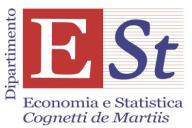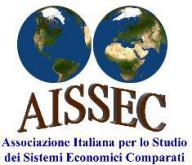22 | SEPTEMBER 2022
Edited by Luca Bortolotti and Marta Marson, University of Turin and OEET
The XXII Italian Association for the Study of Comparative Economic Systems (AISSEC) Scientific Conference held in Pescara in June 2022 collected several contributions on the topic “(Re)discovering the drivers of economic development”. This newsletter contains three articles based on a selection of the contributions focusing on gender inequality.
The challenges faced by women in their multiple roles is indeed an unescapable issue to be addressed to guarantee the achievement of Sustainable Development Goal #5 (Gender Equality). The effect of discrimination is multidimensional, involving employment, health, education, safety, and with positive, i.e. self-reinforcing, feedback mechanisms across dimensions. The articles selected in this newsletter describe gender issues from different perspectives and through different methodologies. They also converge in indicating the fight against gender discrimination and women empowerment are still crucial issues to be addressed for economic and human development.
by Elisabetta Calabresi[*]
The analysis investigates the effect of female education on the prevalence of Intimate Partner Violence (IPV) in Uganda and the channels underlying this effect. I adopt a local randomization approach to a fuzzy Regression Discontinuity Design, exploiting the implementation of the Universal Primary Education policy in 1997. An additional year of schooling decreases the physical IPV index by 7.4 percentage points and the emotional IPV index by 8.3 percentage points on average, for complier ever-in-union women born between 1981 and 1986. The main mechanism behind the impact seems to be assortative matching, while there are no effects on women’s gender attitudes, labor market outcomes, and relationship characteristics. The results are consistent with various robustness checks, and further suggest that the relationship between female education and IPV is context-dependent and that female education may help, but it is not sufficient, for achieving real gender equality.
by Federica Alfani[*], Fabio Clementi[†], Michele Fabiani[‡], Vasco Molini[§], Enzo Valentini[†]
Drawing on various macro- and micro-data sources, the authors present robust evidence of an inverted U-shaped relationship between female labour force participation and inequality. Overall, female labour force participation is found to have a strong and significant dis-equalizing impact in at least three groups of developing countries with relatively low initial levels of participation. A decile-level analysis shows that female labour force participation has higher levels of returns on income among top deciles of the income distribution compared with the lower deciles in the developing countries analyzed. This evidence focuses attention on the importance of developing policies specifically targeting women in lower deciles of the income distribution.
by Emanuela Ghignoni[*], Marilena Giannetti[†] and Vincenzo Salvucci[‡]
This paper explores the evolution of wage gaps in Italy by gender and citizenship. Using Labour Force Survey (LFS) data over the period 2009-2020 we apply two different matching comparison methodologies, the Ñopo decomposition and the Inverse Probability Weighted Regression Adjustment (IPWRA) technique, that allow “like for like” comparisons between individuals and are able to take into account how gender interacts with citizenship in shaping wages. Our findings show that the general gender wage gap in Italy is rather low. This gap is largely explained by workers’ observable characteristics. Conversely, the citizenship wage gap appears to be much larger. Moreover, most of the reported wage gap seem to be explained by unobservable characteristics. We finally estimate the double-negative effect of being both a woman and a foreigner. Non-Italian women earned on average 44.3% per hour less than Italian men in 2009 and 46.5% less than Italian men in 2020.
Our activities
-
11th OEET Workshop Programme
Global Trade Shocks and Geopolitical Uncertainty: Implications for Food Security in Emerging...









